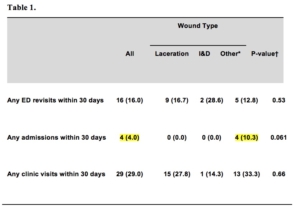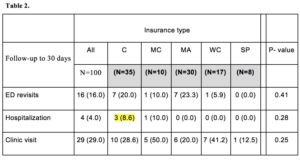Examining Healthcare Utilization After use of a Mobile App for Wound-care Follow Up in the Emergency Department (ED).
Author(s):
David Miranda; Molly Tolins; Heather Evans; Bill Lober; Daniel Hippe; Marie Vrablik
Background:
mPOWEr (Mobile Post-Operative Wound Evaluator) is a mobile health (mHealth) app developed to communicate patient generated health data to healthcare providers.
Hypothesis:
It is feasible to use mHealth in an ED population and to measure follow-up healthcare utilization.
Methods:
To study the feasibility of using mPOWEr in two urban EDs, we examined healthcare use after discharge. Patients seen for laceration repair, abscess drainage, or for other wounds were invited to submit images of their wounds after discharge. Clinical care was not changed based on participation. We compared clinic and ED visits and readmissions in a 30-day post-ED window by type of wound (laceration, abscess drainage, other) and by insurance type (commercial [CI], medicare [MC], medicaid [MA], workers compensation [WC], and self-pay [SP]).
Results:
Of 237 patients approached, 70 (30%) declined and 67 (28%) were ineligible due to lack of personal cell phone. Of 100 enrolled, 59 (59%) submitted at least one wound photo and 70 (70%) had at least one communication of either photo submission or text message. Within 30 days of ED visit, 29% had >=1 clinic visit, 4% were hospitalized, and 16% had a repeat ED visit. There was no difference in ED or clinic visits across wound types. However, all 4 hospital admissions followed ED visits for “other” wounds (p=0.061; table 1). Of admitted patients, 3 (75%) had CI and 1 had MC. There was no significant difference in utilization by type of insurance (table 2), but trends are toward higher utilization with commercial insurance and less by self-payers.


Conclusions:
In demonstrating feasibility of mPOWEr for wound care follow-up, we also observed a variability of post-ED healthcare utilization by wound type and insurance status. There is an opportunity to use mHealth to shift post-ED care utilization in self-pay patients in particular, who are at risk of loss to follow up. Future work will focus on targeting populations to optimize healthcare utilization after an ED visit and validate SSI rates.
